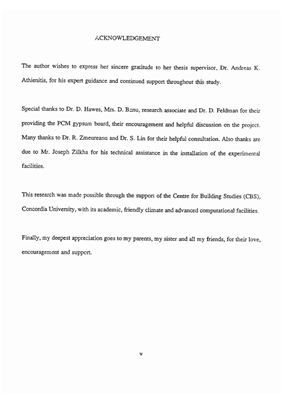На английском языке. Магистерсакая диссертация. Работа выполнена в
Concordia University (Canada), 1993, 107 + XVI pp.
Abstract
Thermal storage use in buildings is a promising approach for the improvement of energy
efficiency. In this study, the feasibility and benefits of utilization of phase change materials (PCMs) in building envelope components for theimal storage were investigated. The phase change material (PCM) gypsum board used in this study was made by soaking conventional gypsum board in a PCM with phase change range of 16.0°C~20.3°C. Both experimental and theoretical studies were performed to investigate the thermal performance of the PCM gypsum board when used in a passive solar building. The experimental study was conducted in a full scale outdoor test-room with the PCM gypsum board as inside wall lining. The test room was equipped with a computerized data acquisition and control system for transient thermal measurements. An explicit finite difference model was developed to simulate the transient heat transfer process in the walls with PCM gypsum board as inside lining. The model takes into
account the transient boundary conditions, absorbed solar radiation, the elting/freezing of the PCM and employed a nonlinear film coefficient. Reasonable agreement between the simulation and the experimental results was observed.
The mathematical model may be used in conjunction with other building thermal analysis software to evaluate the design parameters and the operational characteristics of buildings with wall latent heat storage. This study shows that the utilization of the PCM gypsum board in a passive solar building can effectively limit room overheating by 4-5°C during the daytime and reduce the heating load at night significantly.
Abstract
Thermal storage use in buildings is a promising approach for the improvement of energy
efficiency. In this study, the feasibility and benefits of utilization of phase change materials (PCMs) in building envelope components for theimal storage were investigated. The phase change material (PCM) gypsum board used in this study was made by soaking conventional gypsum board in a PCM with phase change range of 16.0°C~20.3°C. Both experimental and theoretical studies were performed to investigate the thermal performance of the PCM gypsum board when used in a passive solar building. The experimental study was conducted in a full scale outdoor test-room with the PCM gypsum board as inside wall lining. The test room was equipped with a computerized data acquisition and control system for transient thermal measurements. An explicit finite difference model was developed to simulate the transient heat transfer process in the walls with PCM gypsum board as inside lining. The model takes into
account the transient boundary conditions, absorbed solar radiation, the elting/freezing of the PCM and employed a nonlinear film coefficient. Reasonable agreement between the simulation and the experimental results was observed.
The mathematical model may be used in conjunction with other building thermal analysis software to evaluate the design parameters and the operational characteristics of buildings with wall latent heat storage. This study shows that the utilization of the PCM gypsum board in a passive solar building can effectively limit room overheating by 4-5°C during the daytime and reduce the heating load at night significantly.

